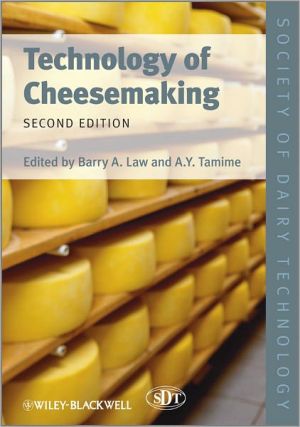

 |

|

Sold Out
Book Categories |
Preface to the Technical Series.
Preface to the Second Edition.
Preface to the First Edition.
Contributors.
1 The Quality of Milk for Cheese Manufacture (T.P. Guinee and B. O'Brien).
1.1 Introduction.
1.2 Overview of milk composition.
1.3 Principles of cheese manufacture.
1.4 Quality definition of milk.
1.5 Factors affecting the quality of milk for cheese manufacture.
1.6 Strategy for quality milk production.
1.7 Conclusions.
References.
2 The Origins, Development and Basic Operations of Cheesemaking Technology (M. Johnson and B.A. Law).
2.1 Introduction.
2.2 The world market for cheese.
2.3 The fundamentals of cheese technology.
2.4 Basic cheese manufacture.
2.5 The stages of cheesemaking.
2.6 Cheese ripening/maturation.
2.7 Reduced-fat versions of traditional cheeses.
2.8 Whey technology for cheesemakers.
2.9 The role of research and development in the future of cheese technology.
2.10 Acknowledgements.
References.
3 The Production, Action and Application of Rennet and Coagulants (M. Harboe, M.L. Broe and K.B. Qvist).
3.1 Historical background and nomenclature.
3.2 Types of rennet and coagulants.
3.3 Molecular aspects of the enzymes in rennet and coagulants.
3.4 Technology of enzymes production.
3.5 Analysis of coagulants.
3.6 Legislation and approvals.
3.7 Physical chemistry and kinetics of enzymatic coagulation of milk.
3.8 Application of rennet and coagulants.
3.9 Conclusions.
References.
4 The Formation of Cheese Curd (T. Janhøj and K.B. Qvist).
4.1 Introduction.
4.2 Chemistry and physics of curd formation.
4.3 Effect of milk composition on curd formation.
4.4 Effects of milk pre-treatment on curd formation.
4.5 Factors controlling curd formation in the vat.
4.6 On-line measurement of curd firmness and syneresis.
4.7 Cheese with reduced-fat content.
References.
5 The Production, Application and Action of Lactic Cheese Starter Cultures (E. Høier, T. Janzen, F. Rattray, K. Sørensen, M.W. Børsting, E. Brockmann and E. Johansen).
5.1 Introduction.
5.2 Historical background.
5.3 Production of starter cultures.
5.4 Range of LAB used as starter cultures.
5.5 Taxonomy of LAB.
5.6 The types of lactic cultures.
5.7 Modern approaches to the development of new starter cultures.
5.8 Biochemistry of acidification by LAB.
5.9 Proteolysis by LAB.
5.10 Bacteriophage of LAB.
5.11 Development of phage-resistant starters.
5.12 Future perspectives in starter culture development.
References.
6 Secondary Cheese Starter Cultures (W. Bockelmann).
6.1 Introduction.
6.2 Surface-ripened cheeses.
6.3 Classification of secondary starter cultures.
6.4 Commercially available secondary cheese starter cultures.
6.5 Surface ripening.
6.6 Development of defined surface starter cultures.
6.7 Proteolysis and lipolysis.
6.8 Aroma.
6.9 Conclusions.
References.
7 Cheese-Ripening and Cheese Flavour Technology (B.A. Law).
7.1 Introduction.
7.2 The breakdown of milk proteins to flavour compounds in cheese.
7.3 Breakdown of milk lipids in cheese.
7.4 Lactose and citrate metabolism in cheese.
7.5 The commercial drive for cheese-ripening and flavour technology.
7.6 Commercial opportunities created by cheese-ripening and flavour technologies.
7.7 Methods for the controlled and accelerated ripening of cheese.
7.8 EMCs and cheese flavour products.
7.9 Acknowledgements.
References.
8 Control and Prediction of Quality Characteristics in the Manufacture and Ripening of Cheese (T.P. Guinee and D.J. O'Callaghan).
8.1 Introduction.
8.2 Principles of cheese manufacture.
8.3 Cheese quality characteristics.
8.4 Cheese quality: influence of chemical composition of milk.
8.5 Cheese quality: effect of milk pre-treatments and manufacturing operations.
8.6 Cheese quality: effect of cheese composition.
8.7 Cheese quality: effect of ripening.
8.8 Quality assurance in cheese manufacture.
8.9 Conclusions.
References.
9 Technology, Biochemistry and Functionality of Pasta Filata/Pizza Cheese (P.S. Kindstedt, A.J. Hillier and J.J. Mayes).
9.1 Introduction.
9.2 Measuring functional properties of pizza cheese.
9.3 Manufacture of pizza cheese.
9.4 Microbiological, proteolytic and physicochemical properties.
9.5 Non-traditional methods of manufacture.
References.
10 Eye Formation and Swiss-Type Cheeses (A. Thierry, F. Berthier, V. Gagnaire, J.R. Kerjean, C. Lopez and Y. Noel).
10.1 Introduction.
10.2 Open texture and eye formation.
10.3 Gas formation through propionic fermentation.
10.4 Cheese structure and eye formation.
10.5 Conclusions.
References.
11 Microbiological Surveillance and Control in Cheese Manufacture (P. Neaves and A.P. Williams).
11.1 Introduction.
11.2 Milk for cheese manufacture.
11.3 Heat treatment.
11.4 Cheesemaking.
11.5 Maturation of the curd.
11.6 Specialist cheeses and cheese products.
11.7 Cheese defects.
11.8 Prevention and control.
11.9 End-product testing and environmental monitoring.
11.10 Microbiological techniques.
11.11 Conclusions.
References.
12 Packaging Materials and Equipment (Y. Schneider, C. Kluge, U. Weiand H. Rohm).
12.1 Introduction.
12.2 Cutting of the cheese.
12.3 Applications of cutting.
12.4 Packaging of cheeses.
12.5 Packaging machines.
12.6 Conclusion.
References.
13 The Grading and Sensory Profiling of Cheese (D.D. Muir).
13.1 Introduction to cheese-grading systems.
13.2 Fundamentals of sensory processing.
13.3 Grading systems: defect versus attribute grading.
13.4 The direct link: cheesemaking to consumer.
13.5 Introduction to sensory profiling of cheese.
13.6 Sensory vocabulary.
13.7 Sample preparation and presentation.
13.8 Assessor selection.
13.9 Integrated design and analysis of data.
13.10 Sensory character of commercial cheese.
13.11 Development of flavour lexicons.
13.12 Overview.
13.13 Acknowledgements.
References.
Index.
Login|Complaints|Blog|Games|Digital Media|Souls|Obituary|Contact Us|FAQ
CAN'T FIND WHAT YOU'RE LOOKING FOR? CLICK HERE!!! X
 You must be logged in to add to WishlistX
 This item is in your Wish ListX
 This item is in your CollectionTechnology of Cheesemaking
X
 This Item is in Your InventoryTechnology of Cheesemaking
X
 You must be logged in to review the productsX
 X
 X

Add Technology of Cheesemaking, Now in a fully-revised new edition, this book covers the science and technology underlying cheesemaking, as practised today in the manufacture of hard, semi-soft and soft cheeses. Emphasis is placed on the technology, and the science and technology are in, Technology of Cheesemaking to the inventory that you are selling on WonderClubX
 X

Add Technology of Cheesemaking, Now in a fully-revised new edition, this book covers the science and technology underlying cheesemaking, as practised today in the manufacture of hard, semi-soft and soft cheeses. Emphasis is placed on the technology, and the science and technology are in, Technology of Cheesemaking to your collection on WonderClub |